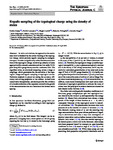Ergodic sampling of the topological charge using the density of states
| dc.contributor.author | Cossu, G | |
| dc.contributor.author | Lancaster, D | |
| dc.contributor.author | Lucini, B | |
| dc.contributor.author | Pellegrini, R | |
| dc.contributor.author | Rago, Antonio | |
| dc.date.accessioned | 2021-08-10T08:39:00Z | |
| dc.date.available | 2021-08-10T08:39:00Z | |
| dc.date.issued | 2021-04 | |
| dc.identifier.issn | 1434-6044 | |
| dc.identifier.issn | 1434-6052 | |
| dc.identifier.other | 375 | |
| dc.identifier.uri | http://hdl.handle.net/10026.1/17536 | |
| dc.description.abstract |
<jats:title>Abstract</jats:title><jats:p>In lattice calculations, the approach to the continuum limit is hindered by the severe freezing of the topological charge, which prevents ergodic sampling in configuration space. In order to significantly reduce the autocorrelation time of the topological charge, we develop a density of states approach with a smooth constraint and use it to study SU(3) pure Yang Mills gauge theory near the continuum limit. Our algorithm relies on simulated tempering across a range of couplings, which guarantees the decorrelation of the topological charge and ergodic sampling of topological sectors. Particular emphasis is placed on testing the accuracy, efficiency and scaling properties of the method. In their most conservative interpretation, our results provide firm evidence of a sizeable reduction of the exponent <jats:italic>z</jats:italic> related to the growth of the autocorrelation time as a function of the inverse lattice spacing.</jats:p> | |
| dc.format.extent | 375- | |
| dc.language | en | |
| dc.language.iso | en | |
| dc.publisher | Springer Science and Business Media LLC | |
| dc.title | Ergodic sampling of the topological charge using the density of states | |
| dc.type | journal-article | |
| dc.type | Journal Article | |
| plymouth.author-url | https://www.webofscience.com/api/gateway?GWVersion=2&SrcApp=PARTNER_APP&SrcAuth=LinksAMR&KeyUT=WOS:001029417100001&DestLinkType=FullRecord&DestApp=ALL_WOS&UsrCustomerID=11bb513d99f797142bcfeffcc58ea008 | |
| plymouth.issue | 4 | |
| plymouth.volume | 81 | |
| plymouth.publication-status | Published | |
| plymouth.journal | The European Physical Journal C | |
| dc.identifier.doi | 10.1140/epjc/s10052-021-09161-1 | |
| plymouth.organisational-group | /Plymouth | |
| plymouth.organisational-group | /Plymouth/Faculty of Science and Engineering | |
| plymouth.organisational-group | /Plymouth/Faculty of Science and Engineering/School of Engineering, Computing and Mathematics | |
| plymouth.organisational-group | /Plymouth/Users by role | |
| plymouth.organisational-group | /Plymouth/Users by role/Academics | |
| plymouth.organisational-group | /Plymouth/Users by role/Researchers in ResearchFish submission | |
| dcterms.dateAccepted | 2021-04-19 | |
| dc.rights.embargodate | 2021-8-12 | |
| dc.identifier.eissn | 1434-6052 | |
| dc.rights.embargoperiod | Not known | |
| rioxxterms.versionofrecord | 10.1140/epjc/s10052-021-09161-1 | |
| rioxxterms.licenseref.uri | http://www.rioxx.net/licenses/all-rights-reserved | |
| rioxxterms.licenseref.startdate | 2021-04 | |
| rioxxterms.type | Journal Article/Review | |
| plymouth.funder | Fields, Strings and Lattices: From the Inflationary Universe to High-Energy Colliders::STFC |


